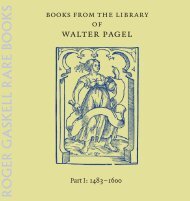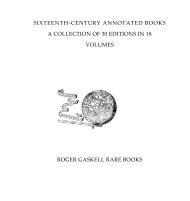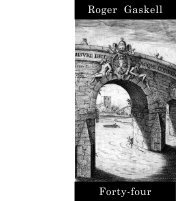pdf - Roger Gaskell Rare Books
pdf - Roger Gaskell Rare Books
pdf - Roger Gaskell Rare Books
Create successful ePaper yourself
Turn your PDF publications into a flip-book with our unique Google optimized e-Paper software.
ut they had little inXuence on subsequent publications.’ (Cazort p.<br />
167.)<br />
Both Casserius and Spigellius had studied with Fabricius in Padua,<br />
and succeeded him in turn in the chair of surgery and anatomy. When<br />
Casserius died in 1616 he left no written text for a projected complete<br />
atlas of human anatomy but only a collection of 86 plates. Spigellius<br />
died in 1625 leaving two unillustrated manuscripts, De humani corporis<br />
fabrica libri decem and De formato foetu. It was left to Spigellius’ young<br />
Polish pupil, Daniel RindXeisch or Bucretius to put together the text<br />
and illustrations, printed from the original plates, adding 20 new<br />
plates by the original artists. He was assisted by Spigellius’ soninlaw,<br />
Liberalis Crema. De formato foetu, with 9 plates, was published Wrst,<br />
at Padua in 1626, followed by De humani corporis fabrica, the present<br />
work, at Venice in 1627.<br />
The design and execution of the plates has traditionally been<br />
attributed to the artist Odorati Fialetti (1573–1638) and the engraver<br />
Francesco Valesio (1560–1648?) who were responsible for the engraved<br />
titlepages. Cazort Wnds no reason to doubt that the designer of the<br />
plates was Fialetti, saying that ‘the imaginative scope of the Casserius<br />
illustrations is in accord with this still under appreciated printmaker’<br />
(Cazort p. 168). On the other hand the variation in the quality of the<br />
engravings suggests that several hands may be at work.<br />
The Wrst engraved titlepage is rather worn, but the second, printed<br />
from the same plate but with the lettering altered, is in much better<br />
condition.<br />
Mimi Cazort, Monique Kornell and K. B. Roberts, The ingenious machine<br />
of nature (1996) pp. 167–8.<br />
176<br />
STENSEN, Nils, or STENO (1638–1686)<br />
Elementorum myologiae specimen, seu musculi descriptio<br />
geometrica. Cui accedunt canis carchariae dissectum caput, et<br />
dissectus piscis ex canum genere.<br />
Florence: ex typographia sub signo stellae, 1667.<br />
4to: ✠ 4 A–P 4 Q 2 , 66 leaves, pp. [8] 123 [1] (last page blank). Woodcut<br />
Medici arms on title, typographical headpieces, woodcut initials.<br />
Woodcut diagrams in the text.<br />
7 plates: 3 large folding woodcut plates numbered Tabula I–III and 4<br />
full page engraved plates numbered Tab. [IV], V, [VI], VII. (bound at<br />
the end with the engravings Wrst).<br />
280 x 167. Small stain in prelims, some very light foxing. A Wne fresh<br />
and clean copy.<br />
Binding: Eighteenthcentury roan backed boards, vellum tips, gilt<br />
tooled spine. A little rubbed, front endleaf removed.







